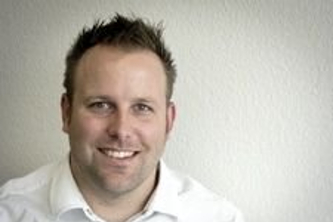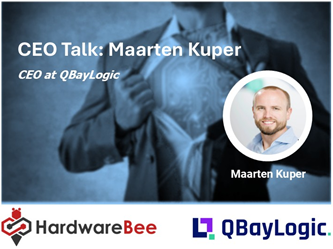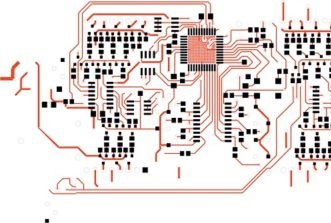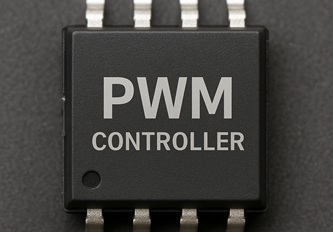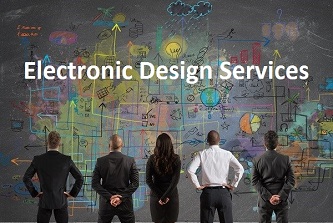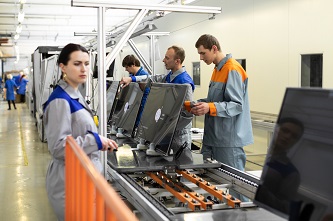CEO Talk – Sven Meier of NetTimeLogic
01/05/2019, hardwarebee
This interview was held with Sven Meier, CEO of NetTimeLogic GmbH.
Tell me a bit about your background? How did you first get started with NetTimeLogic?
I worked for many different companies where FPGAs, time synchronization and network redundancy were always key technologies. I have a strong research background and worked (and still do) in standardization committees and in the R&D department. This was the moment where I came up with the idea to have certain functionalities as kind of coprocessors in an FPGA, which would simplify a lot of things. Unfortunately, I never found the time to implement such an FPGA-coprocessor based solution during my time as an employee. So, in 2014 I started to implement a completely FPGA based time synchronization core in my leisure time, which I initially planned to make as an open source core, but after consolidating the market a bit, I found out that there is an actual market for this. This was the start of NetTimeLogic.
Tell me about NetTimeLogic?
We are still a startup, based in Zurich, Switzerland but serve our customers worldwide.
NetTimeLogic concentrates on modular, fully FPGA based, IP cores for time synchronization, network redundancy and time sensitive networking. We provide IP cores as well as design services and consulting in these areas.
Our goal was and is to reduce the complexity of the integration of such protocols into products and therefore also to reduce the time-to-market for our customers.
When did you start NetTimeLogic? What were you doing before that?
I started NetTimeLogic GmbH in 2015, but started with our IP core development already one year before. Before NetTimeLogic I worked as FPGA and embedded software developer, project manager and product manager for several different companies in the industry, service and research sector. FPGAs, time synchronization and network redundancy have been with me throughout my whole career, so I concentrate with my company also on these topics. True to the motto: do what you do best.
What problem did you see that needed to be fixed? What is your approach to solving that?
During my career I implemented the same time synchronization and network redundancy protocols several times for different companies, or even for the same company. I found it very unsatisfying that there was no out-of-the-box solution for this and I had the impression there must be a simpler way to do this. Also, many of these companies see time synchronization and network redundancy not as a key know-how, but more as something that is needed for the actual functionality, nevertheless they still developed this themselves and bound precious resources to it. So, I thought I will provide the solution for this problem and implemented exactly this: a fully FPGA based time synchronization solution as an out-of-the box product. Kind of a plug and play IP core: instantiate it, connect it and get your synchronized time or network redundancy, without the need for a CPU, software or even know-how of the protocols.
How was the offering of NetTimeLogic changed during the recent years?
Since we started, we extended our portfolio constantly. We started off with one IP core for one specific time synchronization protocol, then implemented IP cores for other time synchronization protocols to allow multi-sync, added network redundancy IP cores to it and finally went into the direction of time sensitive networking. All in a modular way, our goal always was, to have a set of cores that can be combined as needed but still in a simple out-of-the box way, and that is exactly where we are now.
In the recent years the so-called time sensitive networking (TSN) started to be a huge topic in the markets where we are in (automation, utilities, robotics, etc.), so we extended our existing IP cores to support TSN. We are proud to say that we are one of the very few companies that already have a working TSN solution.
Did any of the market consolidation (or acquisition) affected your business and how?
We are in a niche market, there were only two relevant recent acquisitions. One was an acquisition of one of our competitors by a product vendor which was using our competitor’s products already for years. We don’t know yet if this will have any affect for us (good or bad).
The other was an acquisition of another competitor by another competitor of us. This certainly made the competitor stronger since they can profit from their common know-how and joint development force, on the other hand there is now one competitor less. We will see how this will affect our business in the future.
Which market segment seems promising to you? And why?
The automation, robotics and utility industry have a large focus on industry 4.0 and therefore also time sensitive networking (TSN). Since this will be the field bus of the future, allowing vertical integration from the cloud down to the factory floor (as enabler for industry 4.0), companies in this sector are seeking for solution providers to be under the first companies having products supporting TSN. The race is on!
In the next couple of years this will have a significant impact on the whole industrial revolution, and we are proud to be part of it with our TSN solution.
What is a typical customer for NetTimeLogic?
There is no such thing like a typical customer for us, since our products go into many different market segments. However, a lot of customer have a couple of things in common: they need time synchronization, network redundancy or TSN as part of their product, but see this just as a necessary part of their product and don’t want to build up know-how for this and they just need a solution, preferably yesterday. This is where we jump in with our out-of-the-box solutions.
As you can see, we are in the B2B business and end customers seldom see that there is a NetTimeLogic product inside.
Customers are focused on time-to-market, first-time-right, price, etc. Do you see a change in customer behavior in recent years? Where is the focus today and why?
I think the focus on time-to-market has been growing in recent years and will grow even more in the future. We live in an ever faster changing world, where new products have ever shorter life cycles. Since end customer expect new features ever faster, but without reduced quality (or even expect better quality) our customers often change from in-house development to solution providers where they can buy high quality products of the shelf. That way they can have a short time-to-market without compromises on the quality and without binding their development resources to it, so they can focus on the product key features. This is especially true for things where they think that this is not key know-how or a unique selling point for their products.
Price is another point, especially for listed companies with shareholders. These companies feel the pressure for higher profits by their shareholders which often leads to decisions which lead to short term profits, but which are not necessarily sustainable for the future.
What are the 3 top things you wish your customers would do better (or different)?
Requirement engineering: that they really know what they want.
Time planning: more realistic time plans, I know it would be best to have everything by yesterday, but this is not realistic
Think for the future: the best solution is often not the cheapest in the short term, but it will often be future proof and will save money in the long term. Listen to the engineer opinions.
For more information:
Website: https://www.nettimelogic.com/
HardwareBee profile page: https://hardwarebee.com/vendors/nettimelogic/


